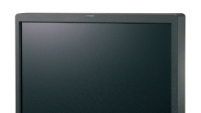Panasonic puts 3-D acquisition in a familiar form factor
Panasonic Broadcast has apparently solved the current dilemma of the ungainly camera rig with the introduction at NAB of its new AG-3DA1 handheld 3D camcorder that will be immediately familiar to users of Panasonic camcorders. The fully-integrated high-definition 3D camcorder offers the ability to record on SD media cards and was officially unveiled at the International CES show in January, amidst the flurry of 3D technology from a wide range of manufacturers on display there.
With interest for the camcorder already running high, the company will build them to order and is accepting a $1000 nonrefundable deposit for each of those interested in purchasing the (list price: $21,000) camera when it ships in the fall. (Details of the program and sales contact information are now available by calling 201-348-5300 or e-mailing.)
Not necessarily adequate for shooting major motion pictures like “Avatar” (which used dual Sony 2/3in sensor cameras mounted side by side), the AG-3DA1 nonetheless should find applications in medical, independent features, documentaries and sports. It weighs less than 6.6lbs and is equipped with dual lenses and two (1920 x 1080) 1/4in CMOS imagers that record 1080/60i, 50i, 30p, 25p and 24p (native) and 720/60p and 50p images using AVCHD compression. It can record for up to 180 minutes on dual 32GB SD cards (in Panasonic’s professional AVCHD PH mode), and offers professional interfaces including dual HD-SDI out, HDMI, two XLR connectors, built-in stereo microphone and twin-lens camera remotes.
Certain issues regarding a stereoscopic viewfinder — which it does not include — and image convergence (how much?) are yet to be decided, but the immediately familiar form factor shows promise for future 3-D cameras (and a possible production switcher) to come.

At NAB Panasonic will also introduce a complementary 25.5in 3-D LCD production monitor (that comes with two polarizing 3-D glasses) in a rugged frame. The 1920 x 1200 native resolution BT-3DL2550 provides “everything a production team would need for 3-D monitoring in the field,” said Joe Facchini, vice president of sales and product management. “It supports older frame compatible 3-D formats and connects easily with common professional interfaces, so it can integrate into any production.”
The monitor displays 3-D content using an Xpol polarizing filter, so content can be viewed with polarizing (passive) 3-D eyeglasses. It switches from left to right image display, overlay, left and right two window display and 3-D.
The BT-3DL2550 features an in-plane switching panel and 10-bit processing circuit (like its existing BT-LH2550 LCD HD production monitor), as well as six color settings (SMPTE, EBU, ITU-R BT.709, Adobe 2.2, Adobe 1.8 and D-Cinema) and a three-dimensional look-up table (LUT) for calibration. It supports 1080i, 1080p and 720p playback, and offers pixel-to-pixel function in 720p mode.
The professional video industry's #1 source for news, trends and product and tech information. Sign up below.
The BT-3DL2550 is equipped with two HD/SD-SDI inputs for simultaneous display of left image, right image and 3-D signals. All 3-D signals can also be supported line-by-line or side-by-side using the monitor’s DVI-D input. Additional professional level inputs include two HD/SD-SDI inputs, component and RGB, as well as standard RS-232C (9-pin) and GPI (9-pin) remote inputs, headphone jack, green and red tally lamps on the front panel. It also has an embedded audio decoder onboard (through its headphone jack), time code display, closed caption (through video input only), audio level meter display of up to eight channels.
The 3-D monitor can be connected directly to Panasonic’s new HD 3-D camcorder and other 3-D cameras via HD-SDI inputs. It can also be connected to high-end NLE systems like Quantel’s iQ and Pablo via its two HD-SDI (simultaneous signal) or to a NLE system running Final Cut Pro via DVI-D (line-by-line signal).
Additional features include preinstalled calibration software, Cine-gamma Film-Rec compensation, Standard Markers and Blue-only, H/V delay display, monochrome and Cross Hatch overlay display, split-screen/freeze frame (live input vs. freeze frame), Five customizable function keys on the front panel can be assigned with various display modes and settings for quick, one-touch adjustments.
The BT-3DL2550 3D production monitor will be available this September.
